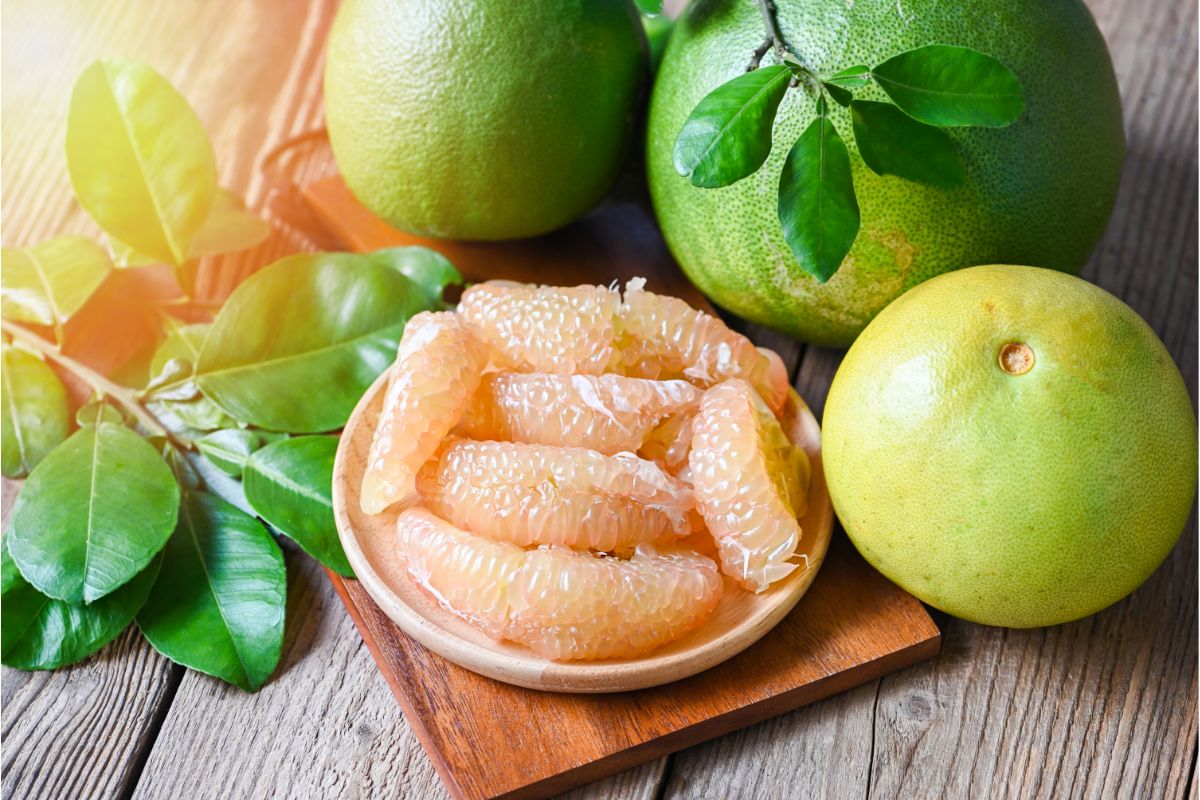If you’re a fan of citrus fruits, you may have heard of the pomelo. This large, yellow-green fruit is known for its sweet, tangy flavor and refreshing juiciness. But what exactly is a pomelo, and what makes it different from other citrus fruits?

In this article, we’ll explore everything you need to know about the pomelo fruit, from its flavor and nutritional benefits to its culinary uses and how to pick and prepare it.
So keep reading to discover all there is to know about the pomelo!
What Is The Pomelo Fruit?
The pomelo is a large citrus fruit that is closely related to the grapefruit and other citrus fruits. It is native to Southeast Asia and some other names for the pomelo include the shaddock, the pummelo, or the Chinese grapefruit.
The fruit is round or oblong and can range in size from a grapefruit to a basketball. The skin is thick and green or yellow, while the flesh is pale yellow or pink and divided into segments.
The flavor of the pomelo is sweet and tangy, with a refreshing juiciness that makes it a popular choice for eating fresh or using in recipes.
In addition to its delicious taste, the pomelo is also rich in nutrients and antioxidants, making it a healthy addition to any diet.
The History Of The Pomelo Fruit
The pomelo has a long history that dates back to ancient times. It is believed to have originated in Southeast Asia, where it has been grown and enjoyed for centuries.
The fruit was highly valued in ancient China, where it was often given as a gift to the emperor and other high-ranking officials.
The pomelo was also used in traditional Chinese medicine to treat a variety of ailments, from coughs and colds to digestive problems.
In the 17th century, the pomelo was introduced to the West by European traders and became popular in countries like Spain, France, and Italy.
It was also brought to the Caribbean and later to the United States, where it was cultivated in Florida and other warm regions.
Today, the pomelo is enjoyed all over the world and is a staple fruit in many Southeast Asian countries, where it is often used in cooking and eaten fresh.
The Nutritional Benefits of the Pomelo Fruit
The pomelo is a highly nutritious fruit that offers a range of health benefits. Here are some of its key nutritional benefits.
High In Vitamin C
One medium-sized pomelo can provide over 100% of the recommended daily intake of vitamin C, which helps boost the immune system and support healthy skin and hair.
Rich In Antioxidants
The pomelo contains antioxidants like flavonoids and carotenoids, which help protect the body against oxidative stress and damage from free radicals.
Low In Calories
The pomelo is a low-calorie fruit, with one medium-sized fruit containing around 100 calories, making it a great choice for those watching their weight.
Good Source Of Fiber
This is a fruit that is also rich in dietary fiber, which helps promote digestive health and can aid in weight management.
Contains Potassium
The pomelo is also a good source of potassium, which plays a role in regulating blood pressure and supporting heart health.
Overall, the pomelo is a nutritious and delicious fruit that can provide a range of health benefits when incorporated into a balanced diet.
Picking And Preparing The Pomelo Fruit

When selecting a pomelo fruit, look for one that is heavy for its size and has firm, smooth skin that is free of blemishes or soft spots.
The skin should also have a slightly springy feel when you press it. The color of the skin can range from green to yellow, depending on the variety and the ripeness of the fruit.
To prepare the pomelo fruit, first wash it thoroughly with water and then dry it. Use a sharp knife to cut off the top and bottom of the fruit.
Make several shallow cuts along the length of the fruit, following the natural segments. Use your fingers to peel away the thick skin and pith, leaving only the juicy pulp. The pulp can then be sliced, diced, or eaten as is.
Some people prefer to remove the thin membrane surrounding each segment of pulp, but this is not necessary and can be time-consuming. The pomelo fruit is usually eaten fresh, but it can also be used in salads, desserts, and drinks.
How To Use The Pomelo Fruit In Cooking
The pomelo fruit can be used in a variety of ways in cooking. Here are some ideas for you to try.
Salad
The pomelo fruit adds a sweet and tangy flavor to salads. Simply combine the sliced or diced pulp with other fruits, vegetables, and greens, and toss with a dressing of your choice.
Juices Or Smoothies

The pomelo fruit makes a refreshing juice or smoothie when blended with other fruits and vegetables. You can also add some honey or sugar for sweetness.
Candied Peel
The thick skin of the pomelo fruit can be candied and used as a topping for desserts, or chopped up and added to baked goods like cakes and muffins.
Marmalade
The pulp of the pomelo fruit can be boiled down with sugar and made into a marmalade that can be spread on toast or used as a topping for yogurt or oatmeal.
Salsa
The pomelo fruit can be diced and combined with other ingredients like red onion, cilantro, and jalapeño to make a fresh and tangy salsa.
Meat Dishes
The pomelo fruit can be used as a marinade or sauce for meat dishes, adding a sweet and sour flavor.
Final Thoughts
The pomelo fruit is a fascinating citrus fruit that is a close relative of the grapefruit. Its history dates back thousands of years, and it is highly valued for its unique taste and nutritional benefits.
It also has a refreshing and slightly sweet taste that is similar to grapefruit but with a milder flavor.
The pomelo is not only tasty but also has a lot of health benefits, including being high in vitamin C, antioxidants, and fiber.
When picking and preparing the fruit, don’t forget to choose a ripe pomelo and remove the thick peel and bitter membrane to get to the juicy flesh inside.
Whether you are a seasoned pomelo lover or have yet to try this fruit, it is definitely worth exploring all the possibilities this delicious fruit has to offer.






